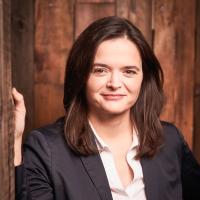







Event
25th Technical Congress - the networking platform celebrates its anniversary
The VDA Technical Congress focused on technologies that will further advance climate-friendly mobility and digitalization. The expansion of the charging infrastructure for electric vehicles and the use of artificial intelligence in production and in vehicles were two key points.
The VDA Technical Congress focused on technologies that will further advance climate-friendly mobility and digitalization. The expansion of the charging infrastructure for electric vehicles and the use of artificial intelligence in production and in vehicles were two key points.
On February 20 and 21, 2024, the VDA invited people to the Technical Congress in the Congress Center (bbc) at Berlin's Alexanderplatz. The 25th anniversary edition of the important industry meeting for representatives from the automotive industry, politics, business and science was held under the motto "Innovative. Digital. Sustainable."
More than 450 decision-makers, specialists and managers discussed the future of mobility and current challenges facing the automotive industry in the midst of its greatest transformation in a solution-oriented manner. Successfully mastering the transformation processes and continuing to enable individual, sustainable and digital mobility is an extraordinary challenge for our industry that brings opportunities and demands the highest level of commitment, performance and passion from everyone involved, said Dr. Marcus Bollig, VDA Managing Director for Product and Value Creation. And he emphasized the importance of networking and personal exchange of experiences with the industry's players:





The constructive and critical exchange with the various stakeholders, who contribute their respective expertise, is central to the successful transformation of our industry. The Technical Congress is now the 25th meeting that promotes precisely this exchange and generates new and creative impulses.Dr. Marcus BolligVDA Managing Director Product and Value Creation

The guests were welcomed by VDA President Hildegard Müller. In her speech, she emphasized the importance of the automotive industry as Germany's innovation engine: "More than one in three euros that companies in Germany invest in research and development comes from the automotive industry. Almost a third of all employees in research areas in the German economy work in the automotive industry."
Bettina Stark-Watzinger, Federal Minister of Education and Research, also addressed the innovative power of the automotive industry when she officially opened the specialist event following Hildegard Müller:





German manufacturers are the first in the world to deliver partially autonomous Level 3 vehicles. Germany is adept at high tech, and the automotive industry even more so. Three points in the area of education and research are essential for an innovative location: research funding, transfer and securing skilled workers.Bettina Stark-WatzingerFederal Minister of Education and Research
The transformation and the increasing international competition are placing great demands on automotive companies in Germany. Therefore, key ideas, innovative concepts and long-term strategies to survive in the international competition between locations and remain a leader were repeatedly the focus of the lectures and panel discussions.
Top-class speakers from politics and business
The exchange between participants, many opportunities for networking and personal discussions with experts during the program items and during the festive evening event have been the hallmarks of the Technical Congress for years. A total of 48 speakers made an important contribution to the content of the congress program with their keynotes, specialist presentations and panel discussions.
Keynotes from political representatives included among others:
- Bettina Stark-Watzinger, Federal Minister of Education and Research,
- Anke Rehlinger, Prime Minister of Saarland,
- Dr. Bettina Hoffmann, Parliamentary State Secretary to the Federal Minister for the Environment, Nature Conservation, Nuclear Safety and Consumer Protection, and
- Richard Damm, President of the Federal Motor Transport Authority
Speakers from industry included among others:
- Dr. Holger Klein, CEO ZF Friedrichshafen,
- Arnd Franz, Chairman of the Management Board MAHLE Group,
- Frank Blome, CEO PowerCo SE,
- Henrik Falk, Chairman of the Board of Berlin Public Transport Company (BVG) and
- Maria Röttger, President Michelin Europe North, Michelin Reifenwerke AG & Co. KGaA.
The program included around 50 keynotes and panel discussions, including 12 themed sessions in which participants discussed various key topics such as autonomous driving, cybersecurity in vehicles, advanced battery technologies, ensuring a stable supply of semiconductors or the potential of hydrogen for decarbonizing the commercial vehicle sector together with all interested parties.

Start-ups: Pitches and cooperation opportunities
The stage is set for a wide range of individual business ideas: The "Start-up Session" on the first day of the event provided further interesting insights, a presentation competition in which eight young automotive companies were able to take part this year. In the short time frame of just three minutes, each company presented its innovative business idea, new platform or technology for the mobility of tomorrow, as well as cooperation opportunities with other industry representatives. The founders then answered questions from the audience.
These start-ups have pitched:
Competitiveness: a central topic in many keynotes
A recurring theme during the two days of the event was competitiveness. For example, in one session, VDA President Hildegard Müller and Prime Minister of Saarland, Anke Rehlinger discussed industrial policy challenges and prospects for the German and European location with Maria Röttger, Head of Northern Europe at Michelin, and Jörg Wuttke, former President of the EU Chamber of Commerce in China.
The focus was on the question of how politics and industry can work together to ensure that the technologies of the future and the globally unique products, ideas and solutions of German automobile manufacturers and suppliers continue to be developed and produced in Germany. The panel agreed on this point: the daily reports of a lack of competitiveness show the urgency of reforms - and what is needed now is a strategic market-oriented economic policy that will make Germany an attractive production and innovation location again. Hildegard Müller specifically called for more political initiative and competitive location conditions: "We now need lower energy prices, faster planning and approval procedures, less bureaucracy and more strategic foresight - especially with regard to raw materials and trade agreements."
The necessary transformation process will undoubtedly be challenging - made clear by Prime Minister of Saarland, Anke Rehlinger. The list of challenges is long: comparatively high wages are coupled with equally high energy prices and a labor market in which skilled workers are both sought after and rare. What is needed now is a determined expansion of renewable energies and investments, especially in infrastructure. "In the past, we ruined our infrastructure by cutting costs. And even a ruined infrastructure is a form of debt, namely towards future generations," Rehlinger said.





We have to make sure that German companies stay in Germany. We don't want to have to import what we produce in Germany today from abroad in the future.Anke RehlingerPrime Minister of Saarland
The challenges are as diverse as the topics of the Technical Congress
The wide range of topics discussed at the Technical Congress makes it clear: the scale of the tasks crucial for achieving climate-neutral mobility is as immense as the tasks manufacturers, suppliers, start-ups and actors from politics and science are already facing today. This makes it all the more important that successes are also discussed - such as the progressive implementation of drive electrification, the expansion of the supply of driver assistance systems and modern sustainable approaches to energy generation, material procurement and production processes. And the diversity of topics also provides an outlook on which changes will play a central role in our society and economy in the future through new products, services and technologies relating to mobility.
But what could this look like in concrete terms? Two examples that were presented at the Technical Congress:





Interview with Johannes Pallasch, spokesperson in the management team of the National Control Center for Charging Infrastructure and department head at NOW GmbH
Mr. Pallasch, in your keynote speech you spoke about the development of charging infrastructure for heavy battery-electric commercial vehicles at depots. The National Control Center for Charging Infrastructure has published the guide "Simple charging at the depot - Guide for the development of charging infrastructure for heavy commercial vehicles" under the umbrella of NOW GmbH. This guide is intended to support companies with truck fleets in their entry into electromobility and in the transformation process towards low-emission logistics. Why is the topic so important at the moment?
Most operators of depots where trucks are loaded and unloaded have to think about electrification. From a technical point of view, this is very complex because, among other things, expensive connection services are required. With this guide, we want to provide clarity about how the process works, how the need is defined, what the implementation steps are and what hurdles there are.
However, the guide does not yet solve the economic problem related to infrastructure. A uniform overall system of truck charging infrastructure must be in place if we want to get the vehicles on the road. Until we get to this point, i.e. during the scaling phase, the infrastructure will not be fully utilized - and we have to fill this gap. In this phase of transition, both electrified road freight transport and the associated charging infrastructure will develop in parallel and gradually adapt to each other.
What is the challenge here?
Often, high initial investments are required, but there are still few vehicles - so I have to spend a lot of money to buy a transformer for my future fleet, for example, but the payback will only come much later. This is a hurdle for the logistics industry, as this industry usually calculates very tightly. Attractive prices and a fair competitive landscape are key to ensuring the successful ramp-up of the overall system.
How are you and your team approaching the expansion of charging infrastructure for commercial vehicles?
We are planning a fast-charging network for trucks together with the Federal Ministry of Transport and the federal company Autobahn GmbH. It is crucial for us that we get the necessary power grid capacities and the necessary parking spaces - both of which are scarce commodities.
As part of this fast-charging network, a total of 4,200 MCS and CCS charging points will be created at 220 managed and 130 unmanaged rest areas. The tender for the unmanaged locations will begin this September. In addition, Autobahn GmbH has already placed network connection orders for the first locations. All of this enables us to quickly scale this entire system.
How can you determine where the need for charging is highest?
Our basic assumption is that the depots are basically electrified. If breaks have to be taken during the journey to recharge, there is a need for public charging infrastructure. Our planning includes all routes from the toll system so that we can digitally map and calculate how the trucks actually move today. We therefore work with real data and translate it into electric driving. This allows our team of traffic modelers to determine when and at which locations public charging is necessary and to calculate the network for this.
How do you prepare the large amount of data for power grid planning?
We have taken an important step by providing transparency with the right information. In the past, the power grid operator would say: I'm happy to expand, but for what? When, where, how, what power and what amount of energy? There was hardly any concrete information in advance, but only when someone said specifically, for example, that they wanted to set up ten fast-charging points in a certain location. However, this information usually came too late because the power grid had to be functioning in advance.
We are now filling this gap by making a basic demand plan for the whole of Germany. We can integrate the current inventory and the additional demand for the overall system into our planning tool, which contains certain assumptions and categories of the various charging station operators. This allows us to indicate very precisely at each location how many charging points are needed - and pass this information on to the power grid planners for the transport sector so that they can determine the development of the distribution networks.
What are the particular challenges when it comes to commercial vehicles?
One challenge is to set up a new, functioning competition system at these locations. The aim is to enable competition that has a positive effect on end customers. It is important, among other things, to enable good prices and to link the energy sector with the transport sector.





Interview with Dr. Corina Apachiţe, Head of the "Program for Artificial Intelligence and Key Technologies", Continental AG
Dear Ms. Apachiţe, how can Continental benefit from AI in the future?
Our aim and our vision is for all 200,000 employees to use artificial intelligence - and I believe that we are not far from this goal thanks to the possibilities offered by generative AI solutions. AI should be available as a tool for a wide range of tasks so that we can shift attention. This means that we hand over tasks that people are very good at today to the machine and we find new tasks for ourselves.
Please give an example of how AI is already being used at Continental today.
When fulfilling orders, we always start by analyzing and reading the performance specifications, which contain requirements and customer requests. There are actually hundreds of thousands of these requirements that have to be checked every day with a lot of manual effort and time pressure. Many of the requirements and clauses contained in them differ little in content from those in projects already completed - and yet they have to be read and evaluated again and again. Of course, people can do this, but in bulk it is uninteresting and quite exhausting. With the help of AI, similarities in the documents can be found and communicated, which is very practical for allowing people to focus on the essentials.
Or: We use an AI we developed ourselves, for example, to calibrate and adjust the function of door control units for anti-pinch protection. When the door control unit is integrated into the vehicle, several thousand parameters have to be specifically adapted to the various models and dependencies. Humans can do this themselves, but it is very time-consuming because many dependencies have to be taken into account. That's why we use an AI that has independently learned from the experience of our engineers and through algorithms to become better than humans. I am convinced that AI on the whole is a great support for us.
How do you and your team manage to develop creative AI solutions?
As a traditional automotive supplier, we have learned well how to establish data science and intelligent automation processes. Not all data is automatically valuable - it takes a lot of effort to generate the data and make it available in such a way that it can be used and thus becomes valuable. You have to educate employees about how valuable data can be.
We have over 1,200 AI experts on board. In 2013, we had already filed 80 patents for the use of artificial intelligence in the automotive industry. Since 2016, we have been strategically expanding our expertise in this field. In 2021, we expanded a global AI team with an AI Lab in Berlin. There, AI experts from different areas of the company work together on solutions for the mobility of tomorrow. For example, a delivery robot was developed here that can drive independently thanks to machine vision and AI applications.
In your session, you explained how AI can improve the driving experience for passengers. How does this work in practice?
We are one of the world's first automotive suppliers to integrate Continental data and artificial intelligence-based technologies from the Google Cloud directly into the high-performance vehicle computer, also known as the "Smart Cockpit." We announced the system for the first time at IAA MOBILITY 2023.
The drivers enter into a natural dialogue with the learning voice system. The basic idea is that people do not have to learn how to operate the machine, but that the machine becomes more "empathetic" and reacts appropriately to human needs in every driving situation. And a lot is possible: with a simple voice command, for example, they can ask for information about popular restaurants or sights on their route. And if the driver wants to know how to charge the smartphone in the vehicle or what the tire pressure is, the dialogue system provides assistance from the vehicle's operating manual. Our goal is to ensure that interaction in the vehicle remains up to date and that user interfaces can be controlled much more intuitively in the future.
Impressive and globally unique products, ideas and solutions
"The innovative strength of our companies is our recipe for success - for transformation and our prosperity. We are seizing the opportunity to further develop our tradition - and at the same time to be pioneers with the aim of shaping the long term," Hildegard Müller said. The Technical Congress has been demonstrating this for 25 years now.
We would like to thank our exhibitors Caresoft Global GmbH, Deloitte GmbH Wirtschaftsprüfungsgesellschaft, ENX Association, Fenecon, Ludwig Heuse GmbH and Siemens AG (see the following picture gallery) and our partners Groupe Michelin, Qualcomm Technologies and ZF Friedrichshafen AG for the wonderful cooperation at the VDA Technical Congress 2024.
The following companies have complemented the exhibition:

Photo credits for all photos: Christian Lietzmann
Questions about the event? Your contacts:





Tineke Geywitz
Team Lead







